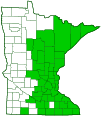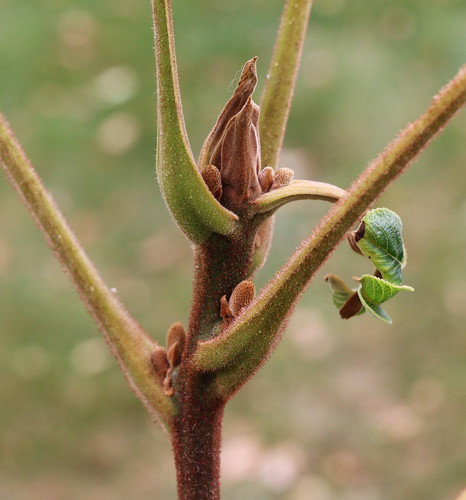butternut
(Juglans cinerea)
Conservation • Wetland • Description • Habitat • Ecology • Use • Distribution • Taxonomy
Description |
||
Butternut is a fast-growing deciduous tree rising on a single trunk. On deep soils the root system includes a taproot and deep, widely spreading lateral anchors. In shallow soils there is no taproot. In Minnesota mature trees are usually 40′ to 60′ tall and up to 25″ in diameter at breast height, though large individuals can reach over 80′ in height and 36″ in diameter. It is short-lived due to susceptibility to root diseases, decays, fungal infection, and invasion by wood-boring insects. The greatest recorded age in Minnesota was 221 years, but it usually does not live more than 75 years. The trunk is slender and often crooked. It is often short and forked or divided into a few large, ascending branches. The crown is broad, open, and rounded on top. The bark on young trees is light gray and smooth. On mature trees the bark is gray to grayish-brown, moderately thick, with irregular, broad, flat-topped, smooth, interlacing ridges and broad, shallow, dark fissures. First-year twigs are stout, green to greenish-brown, and hairy, with small, slightly raised, pale, corky bumps (lenticels). Second-year twigs are stout, green to greenish-brown, and hairless. The pith is finely chambered and dark, chocolate brown. Cut through a twig at an angle and check the pith. If it consists of walls with hollow chambers, looking something like a honeycomb, then the tree is either black walnut or butternut. The leaf scars are raised and inversely heart-shaped. The upper margin is flat or almost flat and has a dense ridge of tan, velvety hairs. There are 3 clusters of bundle scars. The appearance is that of a monkey face with a tan eyebrow. Terminal buds are pale yellow, cone-shaped, flattened, 5 ⁄16″ to ⅝″ long, ⅛″ to 3 ⁄16″ wide, and covered by a few hairy scales. Lateral buds are smaller and are covered with short, soft, matted, woolly, rusty-brown, hairs. The leaves are deciduous, alternate, 15″ to 24″ long, and pinnately divided into 11 to 17 leaflets. They are on 1 3 ⁄16″ to 3½″ long, hairy leaf stalks. The terminal leaflet is present and well developed. The leaflets are nearly stalkless, egg-shaped to oblong lance-shaped, 2¾″ to 5″ long, and 1⅛″ to 2⅛″ wide. They taper to a point at the tip with concave sides along the tip and are rounded or nearly squared and asymmetrical at the base. The upper surface is yellowish-green, wrinkled, rough and sparsely to moderately but evenly hairy. The lower surface is paler, grayish-green, and densely soft-hairy. The terminal leaflet is usually present, well developed, and is about the same size as the 2 adjacent lateral leaflets. The margins are finely toothed with sharp, forward pointing teeth. In autumn the leaves turn yellow or brown. The leaflets are flat, they do not droop downward from the central axis (rachis) of the leaf. Male and female flowers are borne on the same branchlet. They appear early May to early June. The male inflorescence is a slender, 2⅜″ to 4¾″ long catkin drooping from the base of previous-year twigs. The female inflorescence is a cluster of 3 to 7 flowers on a short spike at the tip of current-year twigs. The flowers are pollinated by wind. The fruit is a nut enclosed in a husk appearing singly or in clusters of 2 to 5. The husk is greenish-bronze, thin, oblong to egg-shaped, 2″ to 3⅛″ long, and 1″ to 1½″ wide. It is obviously longer than wide and somewhat pointed at one end. It is covered with glandular hairs making it sticky to the touch. It ripens in early August to early September and is dispersed by animals. The shell of the nut has irregular, jagged ridges. The seed is sweet-tasting. |
||
Height |
||
40′ to 60′ |
||
Record |
||
The champion butternut in Minnesota is on city property near Roseville, in Ramsey County. In 2004 it was measured at 76′ tall and 236″ in circumference (75.1″ in diameter), with a crown spread of 89.5′. |
||
Flower Color |
||
Green |
||
Similar Species |
||
| Black walnut (Juglans nigra) has buff pith in the twigs. The terminal buds are shorter, 3 ⁄16″ to 5 ⁄16″ long. The leaves are divided into up to 23, usually 15 to 19, leaflets. The leaflets droop downward from the rachis. The terminal leaflet is either poorly formed or missing. The leaf scar is deeply notched at the top, not almost straight across, and does not have a band of hairs above it. The upper surface of the leaf is either hairless or has hairs only along the midvein. The fruit is nearly spherical and is not sticky to the touch. | ||
Habitat |
||
Streambanks and hillsides in mixed hardwood forests. Shade intolerant. |
||
Ecology |
||
Flowering |
||
Early May to early June |
||
Pests and Diseases |
||
Butternut Canker (Sirococcus clavigignenti-juglandacearum) is a lethal disease affecting butternut trees. |
||
Use |
||
|
||
Distribution |
||||
|
Sources |
|||
| 4/4/2023 | ||||
Nativity |
||||
Native |
||||
Occurrence |
||||
Uncommon |
||||
Taxonomy |
|||
| Kingdom | |||
| Phylum | Tracheophyta (Vascular Plants) |
||
| Subdivision | Spermatophytina (Seed Plants) |
||
| Class | Magnoliopsida (dicots) |
||
Order |
Fagales (Beeches, Oaks, Walnuts, and Allies) |
||
Family |
Juglandaceae (walnut) | ||
| Subfamily | Juglandoideae | ||
| Tribe | Juglandeae | ||
| Subtribe | Juglandinae | ||
Genus |
Juglans (walnuts) | ||
| Section | Trachycaryon | ||
Subordinate Taxa |
|||
|
|||
Synonyms |
|||
Wallia cinerea |
|||
Common Names |
|||
butternut white walnut |
|||
Glossary
Catkin
A slim, cylindrical, drooping cluster of many flowers. The flowers have no petals and are either male or female but not both.
Glandular hairs
Hairs spread over aerial vegetation that secrete essential oils. The oils act to protect against herbivores and pathogens or, when on a flower part, attract pollinators. The hairs have a sticky or oily feel.
Lenticel
A corky, round or stripe-like, usually raised, pore-like opening in bark that allows for gas exchange.
Pinnate
On a compound leaf, having the leaflets arranged on opposite sides of a common stalk. On a bryophyte, having branches evenly arranged on opposite sides of a stem.
Pith
The spongy cells in the center of the stem.
Rachis
The main axis of a compound leaf, appearing as an extension of the leaf stalk; the main axis of an inflorescence.
Visitor Photos |
|||||
Share your photo of this plant. |
|||||
| This button not working for you? Simply email us at info@MinnesotaSeasons.com. Attach one or more photos and, if you like, a caption. |
|||||
Luciearl |
|||||
Several butternut trees grow near the walking trail in Lake Shore. |
|||||
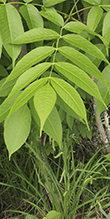 |
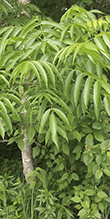 |
||||
Randy |
|||||
Butternut, July 2017, Freeborn County, MN |
|||||
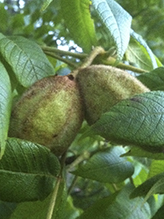 |
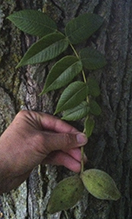 |
||||
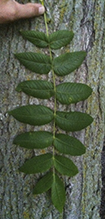 |
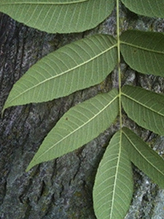 |
||||
MinnesotaSeasons.com Photos |
|||||
Plant |
|||||
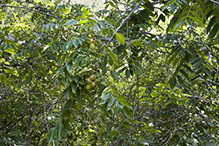 |
|||||
Leaves |
|||||
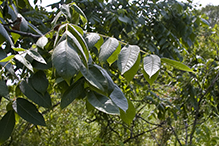 |
|||||
Fruit |
|||||
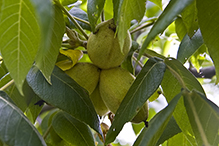 |
|||||

Visitor Videos |
|||
Share your video of this plant. |
|||
| This button not working for you? Simply email us at info@MinnesotaSeasons.com. Attach a video, a YouTube link, or a cloud storage link. |
|||
Other Videos |
|||
| White Walnut identification video wvoutdoorman |
|||
About
Published on Aug 12, 2012 White Walnut identification ( Juglans Cinera ) video : helping ID the tree |
|||
| Trees with Don Leopold - butternut ESFTV |
|||
About
Published on Jun 12, 2012 No description available. |
|||

Visitor Sightings |
|||||
Report a sighting of this plant. |
|||||
| This button not working for you? Simply email us at info@MinnesotaSeasons.com. Be sure to include a location. |
|||||
| Luciearl June 2023 |
Location: Lake Shore Several butternut trees grow near the walking trail in Lake Shore. |
 |
|||
| Randy July 2017 |
Location: Freeborn County, MN |
 |
|||
MinnesotaSeasons.com Sightings |
|||||

|
Created: Last Updated: © MinnesotaSeasons.com. All rights reserved. |
